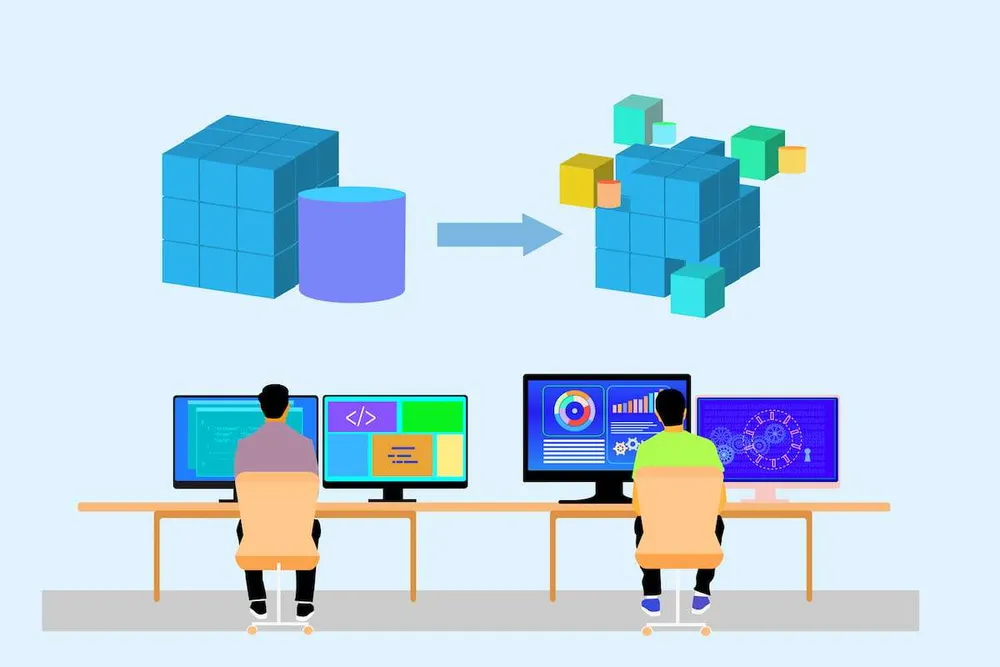What is Microservices Architecture: Understanding the Key Concepts

When building complex apps with many components, developers break them down into manageable chunks to streamline the process. This approach enables professionals to deploy applications without delays and facilitates continuing maintenance. It also opens the possibility of plug-and-play upgrades, facilitating the scaling of selected elements without affecting the whole app. The method involves using elements that are deployed independently and communicate through APIs. In this guide, we will explain the importance of microservices architecture and demonstrate how it can be used to upgrade apps and enhance their scalability.
The Definition of Microservices Architecture
The term refers to an architectural style used by developers to split a complex app into multiple parts, each of which has a particular functionality. When a user sends a request, such apps call on different microservices to produce a relevant response.
Containers serve as examples of this architecture, as they enable professionals to develop services capable of functioning in any environment without any dependencies. Most cloud native applications are typically designed as microservices. This method remains a convenient framework for building, deploying, and upgrading apps.
A single service typically represents a feature designed to perform specific tasks. It communicates with another service via simple interfaces. Even a small team can write and improve such apps with ease, as each element is managed as a standalone unit. It can be upgraded and redeployed without impacting the app’s performance. Separate services are written using different technology stacks, frameworks, and libraries.
Unlike monolithic architecture, microservices facilitate adding new features and editing parts of code without rewriting it fully. They also include such components:
- Orchestration: It allows putting services on nodes, detecting issues, performing rebalancing, etc.
- API gateway: Clients utilize such entry points to call separate services. It allows developers to version the services without upgrading all the clients.
Microservices enable engineers to control app performance at every stage. Improving apps gets easier using container technologies that enable professionals to expedite project completion.

We are confident that we have what it takes to help you get your platform from the idea throughout design and development phases, all the way to successful deployment in a production environment!
Key Benefits of a Microservices Architecture
Expediting the app development process allows businesses to reduce expenses. Using separate units for every feature makes it easier to scale up a project. Utilizing microservices, professionals detect issues and ensure that they won’t impact the functioning of the whole app. Let’s consider the key benefits of this approach:
- An opportunity to implement agile practices: As units are managed independently, developers fix bugs and prepare releases without redeploying an app. It facilitates canceling updates if some features still require improvement. There is no need to wait until an update is tested and published.
- Streamlined coding: When working on advanced apps, developers often have to deal with tangled code, which makes the testing process arduous and time-consuming. However, microservices architecture enables experts to add new options quickly.
- Small teams: It does not take many developers to build a specific feature, which makes the whole process streamlined and fosters communication between team members.
- Data isolation: The method facilitates schema alterations and updates because any changes affect only a single element.
- Different technologies: Every team selects the most suitable technology for a single service.
- Bug isolation: Any issue with a microservice does not affect the whole app.
- Scalability: Developers utilize resources more effectively to scale out the most resource-consuming units.
Despite the noticeable upsides to implementing the approach, it has some shortcomings.

Challenges with Implementing Microservices Architecture
Even though distributed systems have noticeable advantages, businesses must consider some potential shortcomings of using modules. Below, we have outlined some noticeable disadvantages of the approach:
- Complexity: An app with an API-first architecture has more components than a similar monolithic application. While each element is easier to develop and upgrade, the structure is more convoluted.
- Development and testing: Developers should consider how a developed module can be connected to other dependent units. However, many popular tools do not allow working with service dependencies at an advanced level, so it may be challenging to test them.
- Poor governance: Event-driven architecture has its tangible benefits, but some apps are arduous to maintain if they have too many modules written in different languages. Following specific standards may partly solve the issue.
- Latency: The usage of microservices may lead to network congestion and delayed response. When the chain of service gets too long, it is impossible to avoid latency. Queue-based load leveling and API response serialization solve the issue.
- Data consistency: Each module has a data store, meaning that databases are distributed across apps, so maintaining consistency across various services is difficult.
- Management: Companies often face difficulties with correlated logging across services. Leveraging cloud microservices requires embracing time-tested DevOps practices within an organization.
- Versioning: When building an app, developers often need to update several services simultaneously. They should test the compatibility of different versions before deploying modules.
Working on distributed systems requires a particular skill set. Before implementing them, it’s crucial to consider whether a team includes engineers with relevant backgrounds. Otherwise, it may be better to outsource the task to a reputable provider.
Main Stages of Deploying Microservices
When trying to implement distributed systems, companies must follow a clear strategy. Adopting time-tested practices is the best way to succeed. Organizations should follow these steps to avoid pitfalls:
- Identify the features required for stable app functioning: When building an app for an eCommerce store, developers add inventory, delivery, and user management tools, integrate product recommendations, and implement features that allow buyers to leave reviews.
- Build and deploy small services: When the required functionality is identified, developers can build corresponding features. Professionals typically utilize technologies that are perfectly suited for each unit. After developing CI/CD pipelines, developers use CI servers to run automated tests. The services should be able to function independently in different environments.
- Pay attention to design: Developers should consider what protocols they will use.
- Focus on decentralization: Some companies task teams with developing, deploying, and maintaining a microservice they work on. Another approach involves using an internal open-source model. Any developer who needs to change individual features can make the necessary improvements and submit them for approval. This approach requires keeping documentation in order.
- Deploy a feature: Microservices implementation requires writing Consumer Driven Contracts (CDC) for APIs to facilitate upgrades. These CDCs should pass before being deployed.
Following these steps facilitates application development and expedites project completion while minimizing possible risks. To implement distributed systems, firms consider the business capabilities their apps should have. Tasking small teams with designing and building features and selecting the most reliable data service are the main steps a company must take to succeed. Reducing the risk of coupling between services requires teams to avoid sharing database schemas.
Implementing microservices architecture requires using resiliency strategies to isolate failures and prevent gateways from becoming dependencies. Integrating such solutions without extensive experience is laborious without a solid technical background. The Global Cloud Team includes experts who specialize in loosely coupled architecture and build solutions for enterprises across many industries. Contact our professionals today and learn how to leverage containerization to build powerful apps.
Top Articles
What is Hyperautomation: A Comprehensive Overview of Key Components
I am here to help you!
Explore the possibility to hire a dedicated R&D team that helps your company to scale product development.






